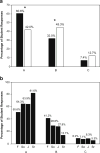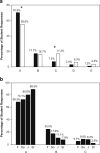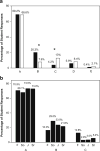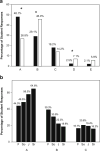Assessment of Biology Majors' Versus Nonmajors' Views on Evolution, Creationism, and Intelligent Design
- PMID: 26973732
- PMCID: PMC4785019
- DOI: 10.1007/s12052-008-0096-x
Assessment of Biology Majors' Versus Nonmajors' Views on Evolution, Creationism, and Intelligent Design
Abstract
The controversy around evolution, creationism, and intelligent design resides in a historical struggle between scientific knowledge and popular belief. Four hundred seventy-six students (biology majors n=237, nonmajors n=239) at a secular liberal arts private university in Northeastern United States responded to a five-question survey to assess their views about: (1) evolution, creationism, and intelligent design in the science class; (2) students' attitudes toward evolution; (3) students' position about the teaching of human evolution; (4) evolution in science exams; and (5) students' willingness to discuss evolution openly. There were 60.6% of biology majors and 42% of nonmajors supported the exclusive teaching of evolution in the science class, while 45.3% of nonmajors and 32% of majors were willing to learn equally about evolution, creationism, and intelligent design (question 1); 70.5% of biology majors and 55.6% of nonmajors valued the factual explanations evolution provides about the origin of life and its place in the universe (question 2); 78% of the combined responders (majors plus nonmajors) preferred science courses where evolution is discussed comprehensively and humans are part of it (question 3); 69% of the combined responders (majors plus nonmajors) had no problem answering questions concerning evolution in science exams (question 4); 48.1% of biology majors and 26.8% of nonmajors accepted evolution and expressed it openly, but 18.2% of the former and 14.2% of the latter accepted evolution privately; 46% of nonmajors and 29.1% of biology majors were reluctant to comment on this topic (question 5). Combined open plus private acceptance of evolution within biology majors increased with seniority, from freshman (60.7%) to seniors (81%), presumably due to gradual exposure to upper-division biology courses with evolutionary content. College curricular/pedagogical reform should fortify evolution literacy at all education levels, particularly among nonbiologists.
Keywords: Assessment; College education; Creationism; Evolution; Intelligent design.
Figures





Similar articles
-
Acceptance of Evolution Increases with Student Academic Level: A Comparison Between a Secular and a Religious College.Evolution (N Y). 2009 Dec;2(4):655-675. doi: 10.1007/s12052-009-0175-7. Evolution (N Y). 2009. PMID: 22957109 Free PMC article.
-
New England Faculty and College Students Differ in Their Views About Evolution, Creationism, Intelligent Design, and Religiosity.Evolution (N Y). 2011 Jun;4(2):323-342. doi: 10.1007/s12052-010-0298-x. Epub 2010 Dec 18. Evolution (N Y). 2011. PMID: 26962385 Free PMC article.
-
Different but equal? How nonmajors and majors approach and learn genetics.CBE Life Sci Educ. 2010 Spring;9(1):34-44. doi: 10.1187/cbe.09-07-0047. CBE Life Sci Educ. 2010. PMID: 20194806 Free PMC article.
-
Science and Creationism: A View from the National Academy of Sciences: Second Edition.Washington (DC): National Academies Press (US); 1999. Washington (DC): National Academies Press (US); 1999. PMID: 25101403 Free Books & Documents. Review.
-
The evolution of creationists in the United States: where are they now, and where are they going?C R Biol. 2009 Feb-Mar;332(2-3):100-9. doi: 10.1016/j.crvi.2008.07.004. Epub 2008 Nov 26. C R Biol. 2009. PMID: 19281943 Review.
Cited by
-
Evolution Controversy: A Phenomenon Prompted by the Incompatibility between Science and Religious Beliefs.Int J Sci Soc. 2015 Jun;7(2):1-23. Epub 2015 May 14. Int J Sci Soc. 2015. PMID: 26877774 Free PMC article.
-
Do Biology Majors Really Differ from Non-STEM Majors?CBE Life Sci Educ. 2017 Fall;16(3):ar48. doi: 10.1187/cbe.16-11-0329. CBE Life Sci Educ. 2017. PMID: 28798210 Free PMC article.
-
Introduction: why people do not accept evolution: using protistan diversity to promote evolution literacy.J Eukaryot Microbiol. 2012 Mar-Apr;59(2):101-4. doi: 10.1111/j.1550-7408.2011.00604.x. Epub 2012 Jan 24. J Eukaryot Microbiol. 2012. PMID: 22273365 Free PMC article.
-
Acceptance of Evolution Increases with Student Academic Level: A Comparison Between a Secular and a Religious College.Evolution (N Y). 2009 Dec;2(4):655-675. doi: 10.1007/s12052-009-0175-7. Evolution (N Y). 2009. PMID: 22957109 Free PMC article.
-
New England Faculty and College Students Differ in Their Views About Evolution, Creationism, Intelligent Design, and Religiosity.Evolution (N Y). 2011 Jun;4(2):323-342. doi: 10.1007/s12052-010-0298-x. Epub 2010 Dec 18. Evolution (N Y). 2011. PMID: 26962385 Free PMC article.
References
-
- Brumfield G. Who has designs on your students’ minds. Nature. 2005;434:1062–5. - PubMed
-
- Dawkins R. The ancestor’s tale. Boston: Houghton Mifflin Company; 2004.
-
- Forrest B, Gross RP. Creationism’s Trojan Horse: the wedge of intelligent design. New York: Oxford University Press; 2004.
-
- Gould SJ. The structure of evolutionary theory. Cambridge: The Belknap Press of Harvard University; 2002.
Grants and funding
LinkOut - more resources
Full Text Sources
